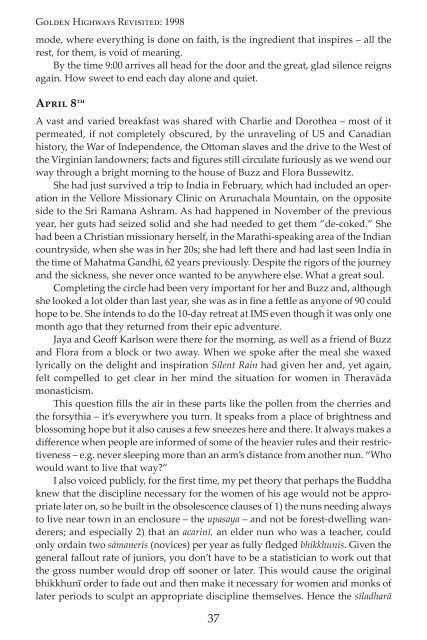Rugged Interdependency - Amaravati Buddhist Monastery
Rugged Interdependency - Amaravati Buddhist Monastery
Rugged Interdependency - Amaravati Buddhist Monastery
- No tags were found...
Create successful ePaper yourself
Turn your PDF publications into a flip-book with our unique Google optimized e-Paper software.
Golden Highways Revisited: 1998mode, where everything is done on faith, is the ingredient that inspires – all therest, for them, is void of meaning.By the time 9:00 arrives all head for the door and the great, glad silence reignsagain. How sweet to end each day alone and quiet.April 8 thA vast and varied breakfast was shared with Charlie and Dorothea – most of itpermeated, if not completely obscured, by the unraveling of US and Canadianhistory, the War of Independence, the Ottoman slaves and the drive to the West ofthe Virginian landowners; facts and figures still circulate furiously as we wend ourway through a bright morning to the house of Buzz and Flora Bussewitz.She had just survived a trip to India in February, which had included an operationin the Vellore Missionary Clinic on Arunachala Mountain, on the oppositeside to the Sri Ramana Ashram. As had happened in November of the previousyear, her guts had seized solid and she had needed to get them ”de-coked.” Shehad been a Christian missionary herself, in the Marathi-speaking area of the Indiancountryside, when she was in her 20s; she had left there and had last seen India inthe time of Mahatma Gandhi, 62 years previously. Despite the rigors of the journeyand the sickness, she never once wanted to be anywhere else. What a great soul.Completing the circle had been very important for her and Buzz and, althoughshe looked a lot older than last year, she was as in fine a fettle as anyone of 90 couldhope to be. She intends to do the 10-day retreat at IMS even though it was only onemonth ago that they returned from their epic adventure.Jaya and Geoff Karlson were there for the morning, as well as a friend of Buzzand Flora from a block or two away. When we spoke after the meal she waxedlyrically on the delight and inspiration Silent Rain had given her and, yet again,felt compelled to get clear in her mind the situation for women in Theravādamonasticism.This question fills the air in these parts like the pollen from the cherries andthe forsythia – it’s everywhere you turn. It speaks from a place of brightness andblossoming hope but it also causes a few sneezes here and there. It always makes adifference when people are informed of some of the heavier rules and their restrictiveness– e.g. never sleeping more than an arm’s distance from another nun. “Whowould want to live that way?”I also voiced publicly, for the first time, my pet theory that perhaps the Buddhaknew that the discipline necessary for the women of his age would not be appropriatelater on, so he built in the obsolescence clauses of 1) the nuns needing alwaysto live near town in an enclosure – the upasaya – and not be forest-dwelling wanderers;and especially 2) that an acarinī, an elder nun who was a teacher, couldonly ordain two sāmanerīs (novices) per year as fully fledged bhikkhunīs. Given thegeneral fallout rate of juniors, you don’t have to be a statistician to work out thatthe gross number would drop off sooner or later. This would cause the originalbhikkhunī order to fade out and then make it necessary for women and monks oflater periods to sculpt an appropriate discipline themselves. Hence the sīladharā37
















